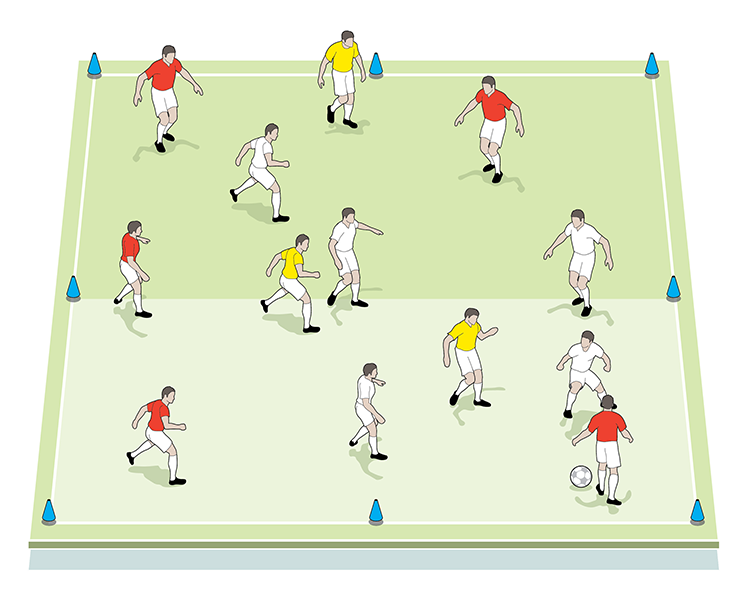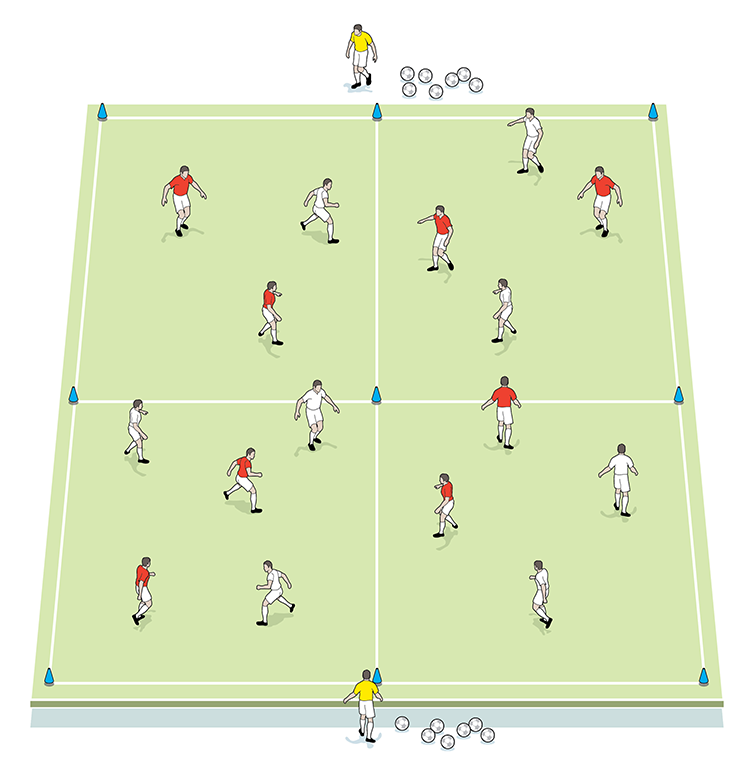




OUR BEST EVER OFFER - SAVE £100/$100
JOIN THE WORLD'S LEADING PROFESSIONAL DEVELOPMENT PROGRAMME
- 12 months membership of Elite Soccer
- Print copy of Elite Player & Coach Development
- Print copy of The Training Ground
You are viewing 1 of your 1 free articles
Aligning possession practices to our tactical model
This session begins by focusing on the defensive transition following possession loss, before training in possession principles of play.
| Area | Up to 40x40 yards |
| Equipment | Balls, cones |
| No. of Players | Up to 8v8 plus 2 neutrals |
| Session Time | 15mins per practice |
This session begins by focusing on the defensive transition following possession loss, before training in possession principles of play.
It’s a practice that fits with the Swansea blueprint of play – it offers high intensity, quickly getting players engaged in what we are trying to achieve. That means what’s being practised can be challenging both physically and mentally, because as soon as players lose the ball they know they will need to work hard to win it back quickly.
Overloaded possession and transition practices
Practice one
We set up as shown (1a) in an area measuring 25x20 yards. Although this can be adjusted depending on the number of players, the aim is always to create challenging in-possession conditions to elicit intensity from the practice.
1a

The game is 5v5 plus three neutral players, who are conditioned to play one-touch. The side in possession plays with an attacking overload while the defending team’s challenge is to regain possession whilst outnumbered.
The emphasis here is on the importance of hunting the ball immediately following possession loss. If the side that loses possession allows the opposition to establish control of the ball (and of play), it becomes a difficult task to regain the initiative in an 8v5 situation.
The way we approach the problem of regaining against an overload is to make a mental line where play is to be restricted (1b). This pressing line would generally represent a half-pitch.
1b

What are the key things to look out for?
This practice enables us to train our pressing reaction when the ball is lost, promoting the physical and tactical ability in players to regain possession quickly; and when they do that, they must quickly make the pitch big. The exercise, through simple execution, allows us to develop this defensive element of our game.
A common mistake occurs when a player will chase the ball by himself, and gets played around easily. It’s important to coach the whole team to press collectively, and to cut off parts of the pitch in eliminating the ‘danger’ of opposition space.
Practice two
The practice area is now split into four even quadrants on a 40x40-yard pitch (2a) that can be used as points of reference or as a way in which a coach, just as in the first practice, can confine players to specific areas of the pitch.
2a

In this example an 8v8 possession game (which includes a supporting yellow neutral player on either side (2b) takes place with each side aiming to complete a sequence of 12 uninterrupted passes. The only stipulation initially is that no more than three consecutive passes can be made in each quadrant before transferring the ball.
2b

Numerous conditions can be placed on this practice in order to hone in on various learning objectives. For example:
- Condition the game so that the point-scoring system is direction-specific – a team must play from one target player to the other in order to score a ‘goal’, and therefore a coach can focus on combination play to pass forward.
- Stipulate that teams retain a minimum of one player per quadrant - this ensures they maintain width and depth within their play.
What are the key things to look out for?
This practice allows us to develop simple game principles. It is crucial that on regaining the ball, as per the previous drill, we make the pitch big - this is the offensive transition. The exercise allows these natural principles to take place with few interventions and cements the idea that, on regaining the ball, we must use width and depth in order to maintain possession.
Related Files
Editor's Picks
Attacking transitions
Deep runs in the final third
Using the goalkeeper in build-up play
Intensive boxes drill with goals
Penetrating the final third
Creating and finishing
My philosophy
Pressing initiation
Compact team movement
Coaches' Testimonials

Alan Pardew

Arsène Wenger

Brendan Rodgers

Carlos Carvalhal

José Mourinho

Jürgen Klopp

Pep Guardiola

Roy Hodgson

Sir Alex Ferguson

Steven Gerrard
Related
Coaches' Testimonials

Gerald Kearney, Downtown Las Vegas Soccer Club

Paul Butler, Florida, USA

Rick Shields, Springboro, USA

Tony Green, Pierrefonds Titans, Quebec, Canada
Join the world's leading coaches and managers and discover for yourself one of the best kept secrets in coaching. No other training tool on the planet is written or read by the calibre of names you’ll find in Elite Soccer.
In a recent survey 92% of subscribers said Elite Soccer makes them more confident, 89% said it makes them a more effective coach and 91% said it makes them more inspired.
Get Monthly Inspiration
All the latest techniques and approaches
Since 2010 Elite Soccer has given subscribers exclusive insight into the training ground practices of the world’s best coaches. Published in partnership with the League Managers Association we have unparalleled access to the leading lights in the English leagues, as well as a host of international managers.
Elite Soccer exclusively features sessions written by the coaches themselves. There are no observed sessions and no sessions “in the style of”, just first-hand advice delivered direct to you from the coach.







